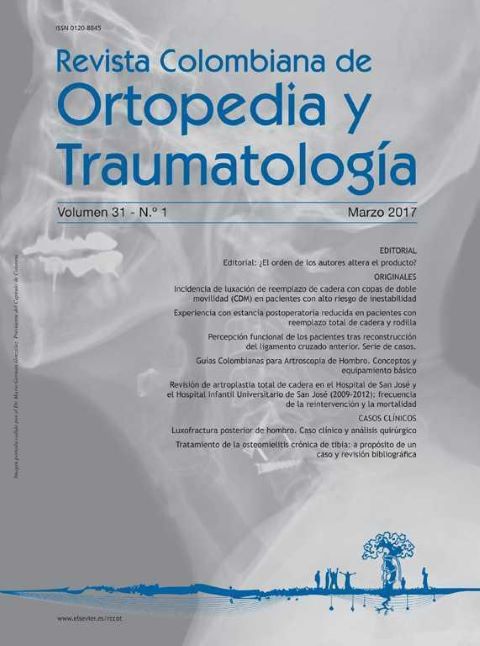Incidence of dislocation after dual mobility cup hip replacement in patients at high risk of instability
DOI:
https://doi.org/10.1016/j.rccot.2017.01.003Keywords:
prosthetic dislocation, dual mobility, risk factors, total hip replacement, hip arthroplastyAbstract
Background: The incidence of dislocation ofthe total hip replacement(THR) is higherin patients with high risk of instability. The use of dual mobility cups (DMC) has a lower incidence of dislocation than conventional prostheses.
Materials and methods: A retrospective cohort study was conducted on patients undergoing THR between 2011 and 2014 with DMC, and operated using the posterolateral approach by the same group of surgeons. The minimum follow-up was 6 months. The incidence of dislocation and the reason for deciding to use DMC was evaluated. Differences between groups were calculated using Fisher’s exacttestfor qualitative variables, and the Wilcoxon testfor continuous ariables.
Results: The study included 103 patients, with a mean age of 79.5 years, and with 73.7% women. The main reasons for using DMC were hip fracture (65%) and revision (31%). The incidence of prosthesis dislocation was 7.7%, with 87.5% of them occurring in women (P=.677). In patients with dislocation, 87.5% had fracture, and 63% had some cognitive impairment.
Discussion: Prosthetic dislocation remains as a problem, even with the use ofthe DMC in patients at high risk. The incidence of fractures and dislocation in revision surgery in our institution is similar to that reported in the literature. In our study, it was noted that dislocations mainly occurred in patients with fracture or with an alteration in mental state, which showed that this second factor was of great importance.
Evidence level: IV. Observational study.
Downloads
References
Caton JH, Prudhon JL, Ferreira A, Aslanian T, Verdier R. A comparative and retrospective study of three hundred and twenty primary Charnley type hip replacements with a minimum follow up of ten years to assess whether a dual mobility cup has a decreased dislocation risk. Int Orthop. 2014;38:1125-9. https://doi.org/10.1007/s00264-014-2313-2
Epinette JA, Béracassat R, Tracol P, Pagazani G, Vandenbussche E. Are modern dual mobility cups a valuable option in reducing instability after primary hip arthroplasty, even in younger patients. J Arthroplasty. 2014;29:1323-8. https://doi.org/10.1016/j.arth.2013.12.011
Bouchet R, Mercier N, Saragaglia D. Posterior approach and dislocation rate: a 213 total hip replacements case-control study comparing the dual mobility cup with a conventional 28-mm metal head/polyethylene prosthesis. Orthop Traumatol Surg Res. 2011;97:2-7. https://doi.org/10.1016/j.otsr.2010.07.008
Wegrzyn J, Tebaa E, Jacquel A, Carret JP, Béjui-Hugues J, Pibarot V. Can dual mobility cups prevent dislocation in all situations after revision total hip arthroplasty. J Arthroplasty. 2015;30:631-40. https://doi.org/10.1016/j.arth.2014.10.034
Ameneiro-Romero L, Louzao-Mosquera P, Souto-Rey V, GareaLoureiro A, Miranda-Blanco JM, Baña-Sandá F, et al. Factores de riesgo y tratamiento de las luxaciones de prótesis de cadera: nuestra experiencia. Acta Ortop Gallega. 2005;1:66-70.
Soong M, Rubash HE, Macaulay W. Dislocation after total hip arthroplasty. J Am Acad Orthop Surg. 2004;12:314-21. https://doi.org/10.5435/00124635-200409000-00006
Plummer DR, Haughom BD. Della Valle CJ. Dual mobility in total hip arthroplasty. Orthop Clin North Am. 2014;45:1-8. https://doi.org/10.1016/j.ocl.2013.08.004
Epinette JA, Lafuma A, Robert J, Doz M. Cost- effectiveness model comparing dual mobility to fixed bearing designs for total hip replacement in France. Orthop Traumatol Surg Res. 2016;102:143-8, 102(2):143-8. https://doi.org/10.1016/j.otsr.2015.12.008
Rondanelli AM. Fracturas de cadera en ancianos. Pronóstico, epidemiología. Aspectos generales. Experiencia. Rev Col Ortop Trau. 2005;19:20-8.
Philippot R, Farizon F, Camilleri JP, Boyer B, Derhi G, Bonnan J, et al. Survival of dual mobility socket with a mean 17 years follow-up. Rev Chir Orthop Reparatrice Appar Mot. 2008;94:43-8. https://doi.org/10.1016/j.rco.2007.10.011
Adam P, Farizon F, Fessy MH. Dual mobility retentive acetabular liners and wear: Surface analysis of 40 retrieved polyethylene implants. Orthop Traumatol Surg Res. 2014;100:85-91. https://doi.org/10.1016/j.otsr.2013.12.011
Saikko V, Sheng M. Wear comparison between a dual mobility total hip prosthesis and a typical modular design using a hip joint simulator. Wear. 2010;268:617-21. https://doi.org/10.1016/j.wear.2009.10.011
Nebergall AK, Freiberg AA, Greene ME, Malchau H, Muratoglu O, Rowell S. Analysis of Dual Mobility liner rim damage using retrieved components and cadaver models. J. Arthroplasty. 2016;31:1595-602. https://doi.org/10.1016/j.arth.2015.12.032
Netter JD, Hermida JC, Chen PC, Nevelos JE, D'Lima DD. Effect of microseparation and third body particles on dual mobility crosslinked hip liner wear. J Arthroplasty. 2014;29:1849-53. https://doi.org/10.1016/j.arth.2014.04.010
Philippot R, Adam P, Reckhaus M, Delangle F, Verdot F-, Curvale G, et al. Prevention of dislocation in total hip revision surgery using a dual mobility design. Orthop Traumatol Surg Res. 2009;95:407-13. https://doi.org/10.1016/j.otsr.2009.04.016
Leiber-Wackenheim F, Brunschweiler B, Ehlinger M, Gabrion A, Mertl P. Treatment of recurrent THR dislocation using of a cementless dual-mobility cup: A 59 cases series with a mean 8 years' follow-up. Orthop Traumatol Surg Res. 2011;97:8-13. https://doi.org/10.1016/j.otsr.2010.08.003
De Martino I, Triantafyllopoulos GK, Sculco PK, Sculco TP. Dual mobility cups in total hip arthroplasty. World J Orthop. 2014;5:180-7. https://doi.org/10.5312/wjo.v5.i3.180
Downloads
Published
How to Cite
Issue
Section
License
Copyright (c) 2024 Revista Colombiana de ortopedia y traumatología

This work is licensed under a Creative Commons Attribution 3.0 Unported License.

| Article metrics | |
|---|---|
| Abstract views | |
| Galley vies | |
| PDF Views | |
| HTML views | |
| Other views | |




